Pest Alert
Authors: Christelle Guédot, UW-Madison Entomology
Last Revised: 12/03/2020
X-number: XHT1271
Black stem borer (BSB), Xylosandrus germanus, also known as the alnus ambrosia beetle, is an invasive beetle from Asia (primarily Japan, Korea, Vietnam, China, and Taiwan) that was accidentally introduced into central Europe and North America. BSB has traditionally been considered a serious pest of nursery and landscape trees, but has also been reported as a pest of fruit crops. In the 1930’s, BSB was first detected in grapes in New York, and more recently, BSB has become increasingly active on fruit trees, particularly in New York and Michigan.
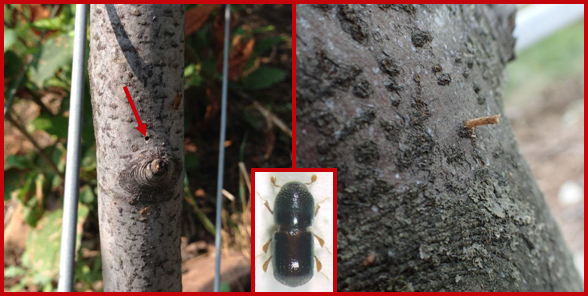
Since 2013, BSB has been detected in 21 counties in Wisconsin (Crawford, Dane, Grant, Iowa, Jefferson, Kenosha, La Crosse, Lafayette, Manitowoc, Milwaukee, Ozaukee, Portage, Racine, Richland, Rock, Sauk, Shawano, Sheboygan, Trempealeau, Vernon, and Waukesha). Prior to 2019, BSB had only been found in Wisconsin at lumberyards and wood waste disposal sites. However, in June 2019, BSB was confirmed in a commercial apple orchard in Lafayette County, WI. The reason for the movement of BSB from ornamentals to fruit trees is unclear, but this movement raises concerns about damage that BSB may cause in commercial orchards in the future.
Appearance: Adult BSBs are small insects that are between 1/8 and 1/16 inches in length. They are reddish brown to nearly black in color and cylindrical. Only females are known to fly. Larvae are small, white, legless grubs.
Host Range: BSB can attack over 200 species of ornamental trees including oak, elm, red maple, beech, hickory, chestnut, magnolia, pear, dogwood, black cherry, tupelo, and black walnut. It can also attack fruit crops such as apple, apricot, cherry, grape, pear and plum.
Symptoms and Effects: Wilting and dieback are typically the first noticeable symptoms of a BSB infestation. These symptoms are the result of defense responses on the part of the tree to the presence of BSB. General tree decline and eventual death often follow. Small holes in the lower trunks of infested trees are another typical symptom of a BSB infestation. Columns of compressed sawdust (called “toothpicks”) often emerge from these holes. Dry, dark-colored, blistery bark and oozing sap are other typical symptoms.
BSB activity may occur in association with plant diseases such as fire blight (see University of Wisconsin Garden Facts XHT1090, Fire Blight) and other canker diseases (e.g., Fusarium canker). It is unclear if stress from these diseases makes trees more attractive to BSB, if BSB is spreading disease-causing organisms, or both.
Life Cycle: BSB overwinters as adults (primarily females) in host trees. Overwintering adults are usually found in higher numbers in wooded areas, and they move to other nearby trees (including orchard trees) from these areas in the spring. Overwintering adults become active in late April to early May following one to two consecutive days where temperatures are 68°F or higher. After mating, females (the only adults known to fly) search for new hosts. They can fly more than 330 feet to colonize new trees. BSB prefers trees that are three inches or less in diameter.
Trees stressed from flooding, frost injury, and drought are particularly attractive to BSB. Stressed trees produce several types of volatile chemicals (including ethanol) that attract BSB.
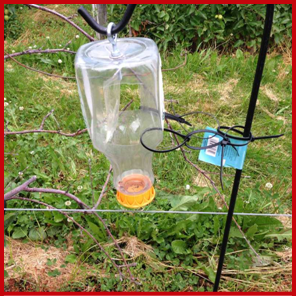
Once females locate suitable trees, they bore holes (approximately 1/16 inches in diameter) in the trunks, typically in the lower two to three feet. Females create a network of tunnels (galleries) under the bark where they lay eggs and where their larvae develop. Females lay one egg per day and can deposit up to 18 eggs. After eggs hatch, larvae develop through three stages (instars) before maturing into adults. This process takes approximately 30 days. New adults typically emerge in July and a second round of mating, tunneling, egg-laying and larval development occurs. The second generation of BSB adults (which overwinters) typically begins to appear around the end of August and into September.
Interestingly, BSB adults and larvae do not feed on plant tissue, but on a symbiotic fungus (Ambrosiella hartigii) that females carry in internal pouches (called mycangia). Females disseminate the fungus in their galleries where it grows and spreads providing a food source for the beetles.
Scouting Suggestions: Routinely examine trees for typical symptoms of BSB (as described above). Also consider using ethanol-baited traps to monitor the flight activity of adult females in the spring. Make traps from one- or two-liter plastic bottles, cutting two to four windows from the sides. Cap the modified bottles and hang them upside down at a height of 20 inches. Concentrate traps around sensitive trees (particularly orchard trees) near wooded areas. Bait traps by adding one cup of vodka (which serves as the ethanol attractant and also the drowning solution) or by hanging a ready-made ethanol lure inside the trap and filling the bottom of the trap with a small amount of a drowning solution (e.g., soapy water or antifreeze). DO NOT use rubbing alcohol in these traps. Check traps at least weekly for drowned beetles. Identification of BSB requires use of a microscope and proper training. If you suspect BSB, send a specimen or good digital photo to the UW-Madison Insect Diagnostic Lab (https://insectlab.russell.wisc.edu/).
Control: Remove and burn infested trees where 75% or more of the branches are dying. Mow (with a flail mower) or burn large brush piles as these may harbor beetles that can cause new infestations. Minimize stresses on trees (as described above) to make them less attractive to BSB. Insecticide treatments may be useful for protecting trees in areas where BSB is a problem. Young trees near woodlot edges are at greatest risk of injury and the most likely to benefit from insecticide applications. However, application of insecticides should be considered carefully as these sprays can negatively impact pollinators. If you decide to spray, treat trunks in the spring when BSB females emerge. This occurs at around 75 growing degree days base 50°F (see University of Wisconsin Garden Facts XHT1086, Degree Day Calculation for details). Follow with a second trunk spray as needed. Use products containing pyrethroids (particularly permethrin). These products can be used on apple trees where they will help control BSB, as well as green fruitworm and spotted tentiform leafminers, two other apple insect pests. Note that because BSB does not feed on woody tissue but rather on the Ambrosiella fungus, systemic insecticides that control other borers will not be effective against BSB.
For more information on black stem borer: Contact your county Extension agent.
Download Article





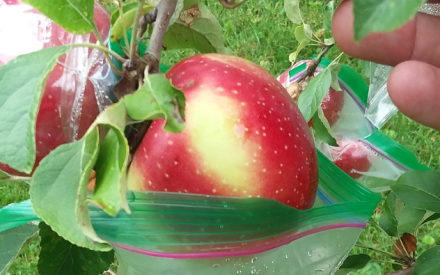 Bagging Apples for Insect and Disease Control
Bagging Apples for Insect and Disease Control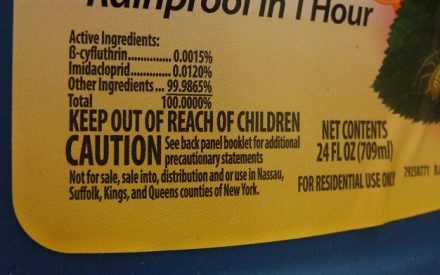 Home Fruit Insecticides
Home Fruit Insecticides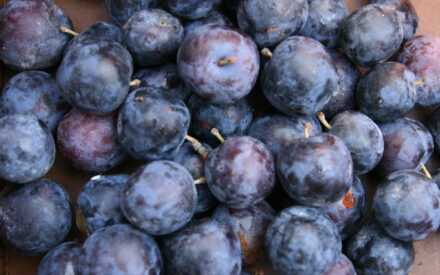 Growing Apricots, Cherries, Peaches, and Plums in Wisconsin
Growing Apricots, Cherries, Peaches, and Plums in Wisconsin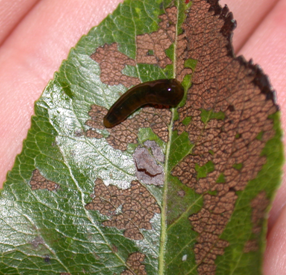 Pear Slug (Pear Sawfly)
Pear Slug (Pear Sawfly)


